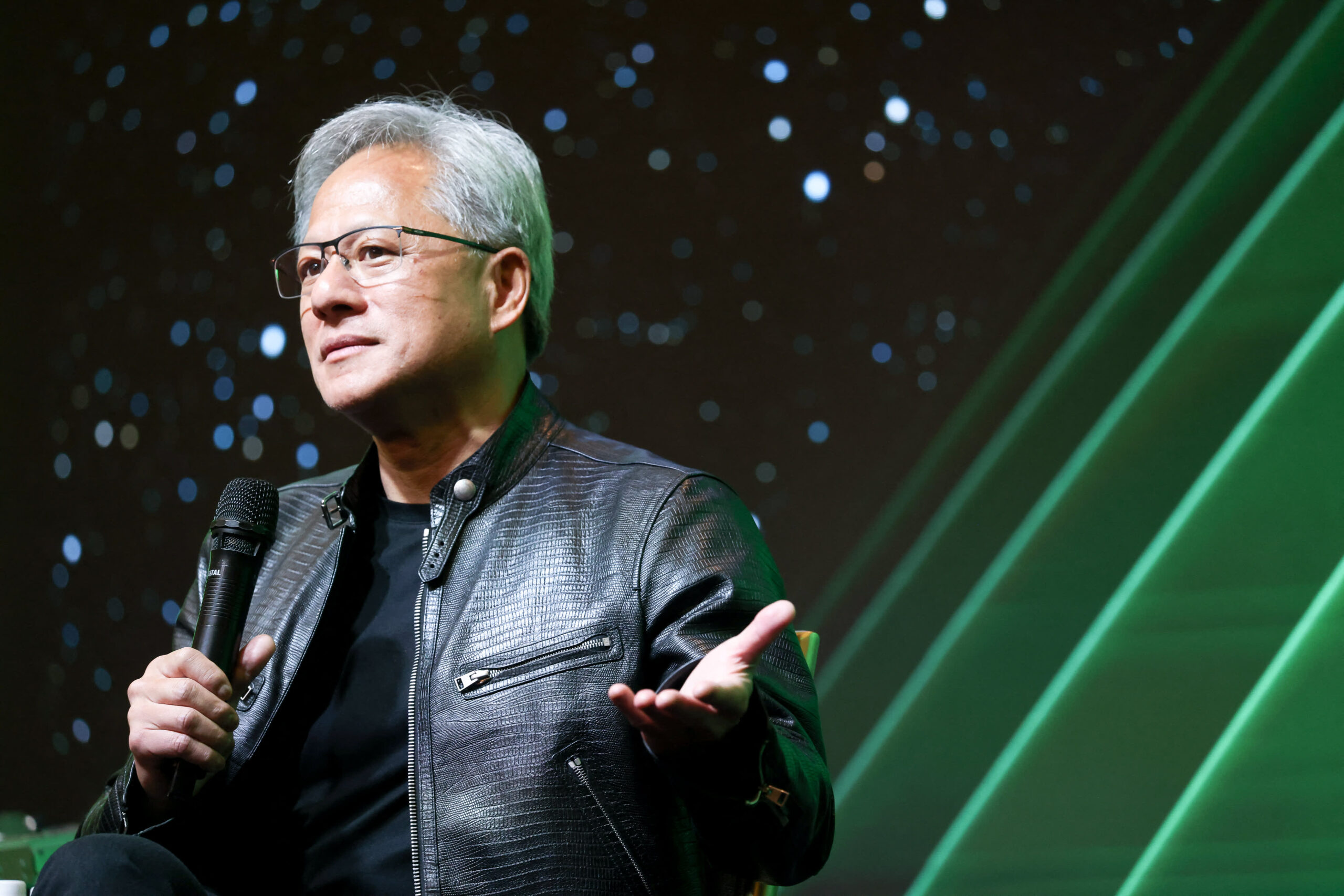
Believe it or not, it’s tough being Nvidia . The dominant maker of processors for use in artificial intelligence has soared 720% since ChatGPT was introduced in Nov. 2022. It’s seen the biggest gain in the S & P 500 this year too, up 160% heading into its earnings results Wednesday evening. At $3.16 trillion, it is now the second-most valuable company on the U.S. stock market, just behind Apple’s $3.46 trillion. Earnings and revenues have doubled in the past year. Nvidia has not only grown earnings and revenues, it has consistently surprised Wall Street, beating on the top and bottom lines for six straight quarters. And that’s the problem: Wall Street has come to believe that beats and raises are part of the DNA for Jensen Huang’s company. “It’s hard to keep raising the bar,” Josh Brown of Ritholtz Wealth Management noted on CNBC Tuesday. Most analysts remain bullish, but agree it’s getting tougher to impress Wall Street. “The outperformance of the stock…indicates a high bar for execution,” Susquehanna analyst Christopher Rolland said in a recent note to clients. It’s not just that it’s getting tougher to beat expectations. Two other warning flags have become evident in the last two quarters. Slowing rate of change in earnings growth There are two important trends to follow in earnings. The first is whether earnings are going up or down. But the second trend is just as important: whether the trend is accelerating or decelerating. If earnings for XYZ stock were rising 5% in 2022, then rising 10% in 2023, and are expected to rise 15% in 2024, that is good because: 1) earnings are going up, and 2) the rate of change of the earnings is increasing. In the case of Nvidia, earnings are continuing to increase, but the rate of change is decelerating. Nvidia earnings (year-over-year % change) Feb. 2025 (est.) + 52% Nov. 2024 (est.) + 77% Aug. 2024 (est.) + 138% May 2024 + 461% Feb. 2024 + 486% Nov. 2023 + 593% Aug. 2023 + 429% Source: LSEG You can see Nvidia’s peak change in year-over-year earnings growth occurred toward the end of last year, and has been rapidly declining since. This earnings report will likely be the final time in this stretch that Nvidia will see triple-digit earnings growth. Another issue: even though Nvidia’s stock price is up, the earnings multiple (P/E ratio), or how much an investor is willing to pay for a future stream of earnings, has also increased. The forward multiple has increased from 40 times earnings to 47 for this fiscal year (February 2024-February 2025), and from 23 to 33 for the following fiscal year (February 2025-February 2026). For fundamental investors, both of these signs (decelerating earnings growth, higher multiple) are cautionary flags. “There are some things I’ve learned in my two decades on Wall Street: when you’ve got expensive valuations and decelerating growth rates from astronomical valuations, there is not a lot of margin for error,” Lori Calvasina, head of U.S. equity strategy at RBC Capital Markets, told CNBC at the end of June, while discussing Nvidia’s earnings growth. Magnitude of earnings beats getting smaller Another set of numbers that have gotten smaller – the magnitude of Nvidia’s beats is getting smaller. This indicates analysts are getting caught off-guard to a lesser extent than they were in prior quarters. It’s a sign it’s getting tougher to impress Wall Street. Nvidia: earnings surprises are getting smaller (earnings beat) May 2024: 10% Feb. 2024: 11% Nov. 2023 19% Aug. 2023 29% Source: LSEG Nvidia’s impact on S & P 500 earnings also slowing Nvidia earnings are still the most important of the season. But the impact has been shrinking – just as the overall Mag 7 impact has been diminishing with second quarter earnings growth broadening out. Last season (Q1), Nvidia was responsible for a little more than one-third of the S & P 500’s 8% earnings growth. This quarter though, it’s expected to make up just 16% of the index’s nearly 13% growth. There are two major issues for Nvidia: will spending on AI continue at its breakneck pace, even if profitability is elusive, and will Nvidia be able to keep rolling out new and innovative products? On the AI spending front, despite concerns about an “air pocket” in demand, Nvidia’s largest customers continue to keep spending. Microsoft and Meta Platforms , two of Nvidia’s largest customers, have indicated spending remains strong. “Neither one of them have given any indication they are lessening their orders to Nvidia,” Josh Brown noted, adding that 45% of Microsoft’s capital expenditures are going to Nvidia. Analysts agree that spending remains strong. “With U.S. cloud and social media companies pointing to data center (and particularly AI) investment as the catalyst for increased spending, and reiterating their commitment to investing in AI we see this shift as boding well for NVDA’s CQ2 results,” Wedbush analyst Matt Bryson said, raising his fiscal second quarter estimates. As for new product, there have been concerns about delays in Nvdia’s Blackwell graphics processing unit (GPU), which is supposed to deliver much faster performance than its Hopper predecessor, and was supposed to be released in 2024. CEO Huang had previously said he expected to see “a lot” of Blackwell revenue this year. Analysts seem unconcerned about any potential delays in the Blackwell GPUs. “Our discussions with industry participants suggest that potential delays are likely to be measured in months rather than quarters,” Stifel said in a note to clients last week. “We are confident that the Blackwell delay will be resolved, and not prove materially detrimental to NVDA or any one of its multitude of industry partners.” Evercore analyst Mark Lipacis, in a note to clients, said “while a negative announcement could have a negative 5%-to-10% near term impact to the stock, NVDA has proven adept at quickly coming up with alternative solutions. Furthermore, should a delay manifest, we believe demand is so strong … that current generation Hopper solutions would be purchased even if Blackwell was pushed.” “The ramp of the H200 [GPU] and forthcoming Blackwell launch likely means AI demand outstrips supply through at least mid-calendar 2025, as Generative AI and investments in large language models are driving robust demand,” CFRA Research analyst Angelo Zino said in a recent note. Most believe AI ‘ramp’ in early stages Ultimately whether you are a bull or a bear on Nvidia depends on where you believe we are in the ” AI ramp .” Most analysts remain believers that we are at the start of a much larger ramp, a position long maintained by tech uber-bull Dan Ives at Wedbush. “While investors may fret about this massive spending wave and frustrated that top-line growth/margins from these investments could take time to materialize this ultimately speaks to our view this is a 1995 (almost 1996) start of the Internet Moment and not a 1999 Tech Bubble-like moment,” Ives said. And that is what keeps the true believers buying, despite the warning flags. “Any earnings disappointment from Nvidia has been an unbelievable opportunity to buy over the long term,” Brown said.
EMEA Tribune is not involved in this news article, it is taken from our partners and or from the News Agencies. Copyright and Credit go to the News Agencies, email news@emeatribune.com Follow our WhatsApp verified Channel





